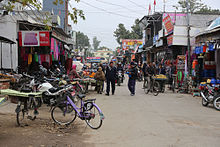Banbasa | |
|---|---|
Town | |
 Banbasa Canal Range | |
| Coordinates: 28°58′48″N 80°04′48″E / 28.979913°N 80.080032°E | |
| Country | |
| State | Uttarakhand |
| District | Champawat |
| Elevation | 466 m (1,529 ft) |
| Population (2011)[1] | |
| • Total | 7,990 |
| Time zone | UTC+5:30 (IST) |
| PIN | 262310 |
| Telephone code | 91 5943 |
| Vehicle registration | UK-03 |
| Website | uk |
Banbasa is a census town in Champawat district in the state of Uttarakhand, India most famous for its border crossing into Nepal from India. The major occupation is agriculture.
Demographics[edit]
As of 2011[update] India census, Banbasa had a population of 7,990,[1] up from 7,138 in 2001.[2] The human sex ratio of Banbasa is 887, with 52% of the population being Male and other 48% female.[1] Children constitute 12.22% of total population of Banbasa.[1] The literacy rate of Banbasa is 77.19%.[1] The Buksas and Tharus are the native inhabititants of the region.[3][4]: 506, 512
It is located 10 km away from Tanakpur. Banbasa is known for the Banbasa Barrage and Dam across the Sharda river, its canal and what many consider the launching point for the trip up into the mountains on the Holy Purnagiri Pilgrimage. The place abounds in sugarcane, paddy, wheat, mango orchards etc. and has a hot and humid climate, typical of the Terais, during summers, with heavy rains in late summers and hard winters.
To enter into Banbassa from Delhi one must pass through a lush 6 km stretch of jungle in which elephants, leopards, tigers, monkeys, bears, snakes, deer and many other species of wild animal are regularly seen. Much of Banbasa's outer population lives in the jungles that surround the town.
The town and tourism[edit]

While Banbassa has several small hotels, it is not generally considered a 'tourist destination'. The majority of tourists and visitors that arrive in Banbasa are either crossing into Nepal (via Mahendranagar) or heading up in to the Himalayas and its hill stations.
A popular place to visit while staying in Banbasa is The Good Shepherd Agricultural Mission, an orphanage home for around 80 orphan children located just 1 km from the town -though visitors must obtain permission prior to visiting via their website. The GSAM is situated on the border of the jungle and has been registered and running since 1948.
Banbasa is a popular spot for people to cross into Nepal from India as there is an immigration office for both countries. The Nepal border is about 5 km from Banbasa and rickshaws, tuktuk or horse-drawn carts can be hired with ease. Vehicles can also cross the border into Nepal/India but specific times are held when this can happen (3-4 times per day).
Transport[edit]
Buses run direct between Banbasa and Delhi, Agra, Bareilly, Rudrapur, Nanital, Haldwani, Dehradun, Haridwar, Amritsar, Chandigarh, Shimla and many other places. Most services have several timings but some only have 1-3 buses per day. Banbasa is one of the last stops before the Himalayan mountain climb begins on the road to Almorah, Champawat and Pithoragarh.
Trains also run to Banbasa, a direct line from Delhi via Bareilly.
Banbasa is near India's border with Nepal, across from the Mahendranagar municipality. Nepalese and Indian nationals may cross unrestricted, however there is a customs checkpoint for goods and third country nationals.
References[edit]
- ^ a b c d e "Banbasa City Population Census 2011 - Uttarakhand". www.census2011.co.in. Retrieved 10 July 2017.
- ^ "Census of India 2001: Data from the 2001 Census, including cities, villages and towns (Provisional)". Census Commission of India. Archived from the original on 16 June 2004. Retrieved 1 November 2008.
- ^ Elliot, Sir Henry Miers; Beames, John (1869). Memoirs on the History, Folk-lore, and Distribution of the Races of the North Western Provinces of India: Being an Amplified Edition of the Original Supplemental Glossary of Indian Terms. Trübner & Company. p. 20.
- ^ Pande, Badri Datt (1993). History of Kumaun : English version of "Kumaun ka itihas". Almora, U.P., India: Shyam Prakashan. ISBN 81-85865-01-9.

